From the moment you arrive on Vancouver Island there’s an unmistakeable sense of calm that sets in and a feeling that you’ve come to the right place. What we love about the island besides its wild natural beauty and laid-back atmosphere, is how quickly the scenery changes. Drive just 20 minutes and you’ll feel like you’ve entered a completely different place, each with its own unique atmosphere and beauty. One moment you could be surrounded by pure nature, deep in old growth forest with the sound of ocean lapping the shore. The next, you could be enjoying locally roasted coffee watching the world go by in an artsy cafe. Whatever you are looking for, Vancouver Island offers so much to visitors and residents alike.
In this guide we’ve put together recommendations of the must see places across southern, central and northern Vancouver Island from well-known sights to hidden gems; wild beaches to ancient rainforests and quaint seaside towns. We’ve also included additional spots that are worth checking out if your schedule allows. Keep in mind that driving distances can be long and road conditions can sometimes be challenging, so if you’re short on time, you may want to stick to just one area.
Map of the must see places on Vancouver Island
Vancouver Island lies off Canada’s Pacific coast and spans a vast 31,285km2. To give a perspective of how big the island is, it takes approximately 6 hours to drive from Victoria in the south of the island to Port Hardy in the north. Due to its size, we’ve divided the island into 3 regions: southern, central and northern Vancouver Island.
The southern tip of the island includes British Columbia’s capital city, Victoria, as well as surrounding farmland in the Cowichan Valley and the rugged southwest coastline.
The central section of the island includes peaceful towns along the eastern coast as well as the wild west Pacific coastline that encompasses Tofino, Ucluelet and the Pacific Rim National Park Reserve.
North of the island, is the most remote and many areas are difficult to reach. Along the east coast you will find wildlife viewing opportunities as well as laid back towns situated in the Commox Valley.

Must see places: Southern Vancouver Island
Sheringham Point Lighthouse
How to get here: 1 hour from Victoria via Route 14.
What to do here: Enjoy panoramic coastal views, learn about the history of the lighthouse, watch marine wildlife
Located along the southwestern coast, Sheringham Point Lighthouse has a beautiful setting, rivalling those found in Nova Scotia and Prince Edward Island. Built in 1912 after a series of shipwrecks in the area, this National Heritage Lighthouse is now owned, operated and cared for by the Sheringham Point Lighthouse Preservation Society.
The lighthouse is open daily and is easily accessible from the parking lot at the end of Sheringham Point Road in the small community of Shirley. From the lot it’s just a 10 minute walk down to the site. Besides its historic charm and gorgeous setting, we also highly recommend this spot for marine wildlife watching. We can almost guarantee a sighting from here. Seals love to swim in the kelp below the lighthouse, sea lions may relax on the rocky islands just off the shore and whales are often seen out in the Juan de Fuca Strait.

Sombrio Beach and hidden waterfall
How to get here: 1.5 hours from Victoria via Route 14. After Jordan River, Route 14 becomes rough and winding with sections of the road giving way.
What to do here: Surfing, swimming, sunbathing, waterfall walk
When most people think of the wild Pacific coast, Tofino often comes to mind, but head to the remote southwest corner of Vancouver Island and you’ll find a secluded stretch of coastline where rainforest meets rugged shores. Sombrio Beach, in our view, is a perfect piece of Pacific paradise where you can surf, swim, sunbathe and explore tidal pools or the forest. Plus, it is absolutely beautiful.
It’s also a favourite among locals, seasoned surfers and hikers who often use the beach as an overnight stop along the Juan de Fuca Trail. Despite its popularity, Sombrio rarely feels crowded. The beach is long and varied with pebbly sections and pockets of sand. If you’re willing to walk a little further down the shore, you’ll find quiet, secluded spots even on busy summer weekends. The beach is framed by towering trees that provide ample shade, and there are several spots to hang a hammock and relax. Surfing at Sombrio is especially popular with locals thanks to consistent Pacific swells, while swimmers tend to gather near the first section of the beach.
What truly sets Sombrio apart is its hidden waterfall that looks like it’s been taken from a tropical jungle oasis. Tucked away just up from the beach, water cascades through a narrow gorge surrounded by bright green moss and ferns. It’s one of the most special and unique waterfalls in Canada.
To find the waterfall, head to Sombrio Beach East until you spot a creek flowing into the ocean. Follow the creek inland through the trees and soon you’ll arrive at the waterfall.


Botanical Beach
How to get here: 2 hours from Victoria via Route 14 (30 minutes north of Sombrio Beach); 10 minutes from Port Renfrew.
What to do here: Explore tidal pools, hike, spot marine wildlife
Located about 30 minutes north of Sombrio Beach, Botanical Beach isn’t your typical beach destination for swimming or surfing, but it’s easily one of the most fascinating natural wonders on Vancouver Island.
A short 1km hike through forest brings you to the beach, where, during low tide, you can explore hundreds of tidal pools teeming with marine life including starfish, urchins and giant, colourful anemones. It’s like peering into a natural aquarium.
As well as exploring the tidal pools, keep an eye out for gray whales, humpbacks, orcas, seals and even sea otters, all of which we’ve seen from the shore. Botanical Beach is a must for nature lovers.


Victoria
How to get here: Ferry from Vancouver (Swartz Bay terminal) + 30–40 min drive to downtown; or via Harbour Air floatplane/ferry directly into downtown.
What to do: History, gardens, museums, harbour walks, whale watching, shopping, cycling, dining
Victoria, the capital city of British Columbia, is often the first stop for travellers arriving on Vancouver Island. The city is compact and walkable, making it easy to explore on foot or by bike for a day.
At the heart of it all is the Inner Harbour, a pretty waterfront lined with sailboats and impressive buildings like the Fairmont Empress Hotel and the BC Parliament Buildings, which are beautifully lit up at night and surrounded by colourful gardens in the summer. From here, you can hop on a harbour taxi ferry or stroll the seawall to Centennial Park and enjoy views across the water. Continue on to Fisherman’s Wharf where you’ll find casual eateries, boutique shops and colourful houseboats.
In the centre of Victoria, it is worth checking out Government Street for its shops including Rogers Chocolates, Munro Books and Makers, a store specialising in locally made products. At the north end of Government Street is Canada’s oldest Chinatown. Check out Market Square and Fan Tan Alley for independent stores.
About 30-minutes drive out of the city is one of Victoria’s top attractions, the world-renowned Butchart Gardens. Explore the 55-acre floral display and enjoy the Japanese, rose and sunken gardens.
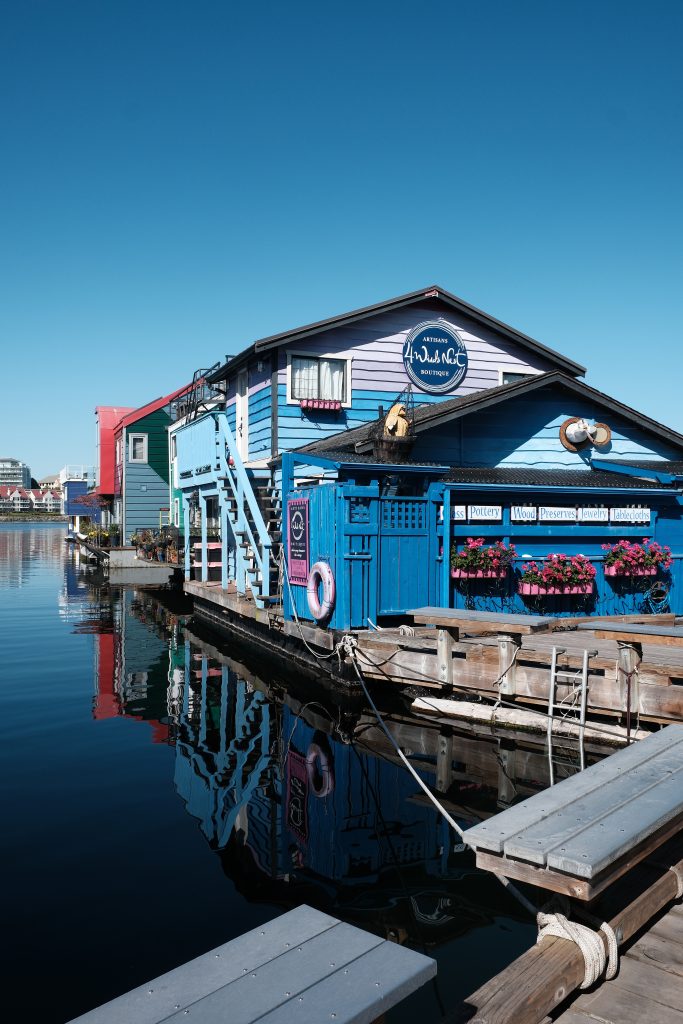
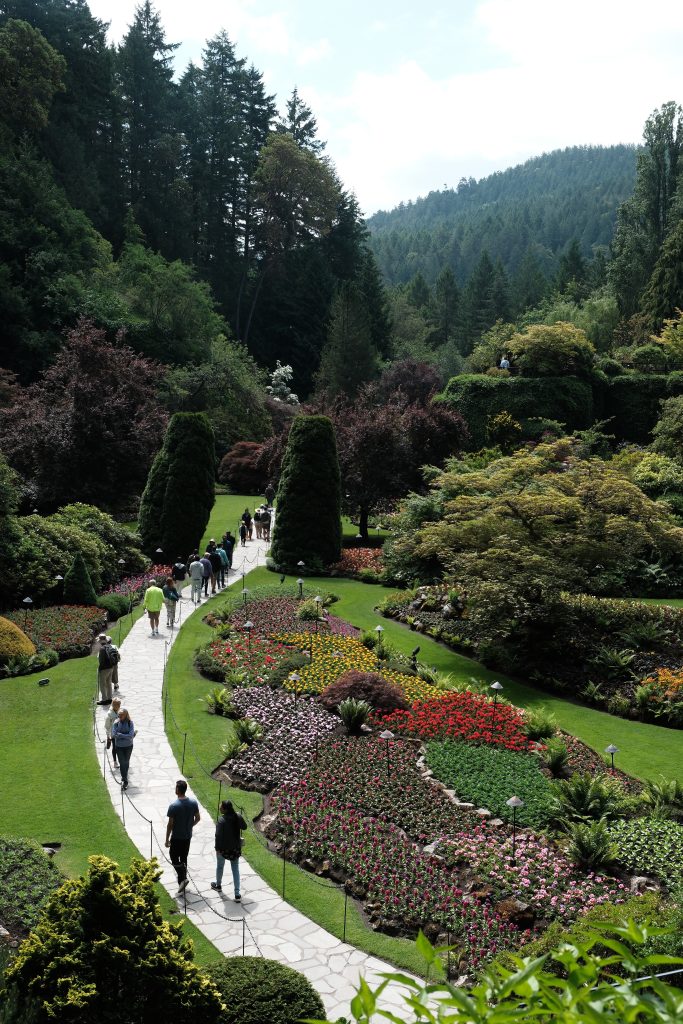
Other places to visit – Southern Vancouver Island
While the places listed above in this guide, definitely need a spot on your Southern Vancouver Island itinerary, the below places are also well worth a stop if you have time to do so:
Cowichan Bay: Tucked away on the south-central coast of Vancouver Island, Cowichan Bay is a small seaside village known for its colourful floating homes, artisan shops, and laid-back vibe. Wander around on a sunny afternoon and stop for a bite to eat overlooking the water. Or check out the main street where you’ll find unique boutiques, art galleries, and a bakery. Visit the Cowichan Bay Maritime Centre for a glimpse into the area’s shipbuilding history, or rent a kayak and paddle along the calm waters of the bay. It’s an ideal stop on a drive between Victoria and Nanaimo, and a lovely place to spend some time browsing, dining, or just taking in the views.
French Beach Provincial Park: Located between Sooke and Jordan River, French Beach is an easy-to-access spot that offers classic west coast scenery without the long hike. The pebble beach stretches along a rugged shoreline backed by dense forest, with views across the water to the Olympic Peninsula. It’s a great place for a picnic, a walk along the driftwood-strewn shore, or watching for whales and eagles. With its day-use area and campground, French Beach is ideal for both a quick stop or an overnight stay close to nature.
China Beach: Located just beyond Jordan River, China Beach, like many along this coastline, is a peaceful and wildly beautiful beach. A 20-minute walk downhill from the parking area leads to the beach. It’s perfect for picnicking, beachcombing, or watching the waves roll in. On clear days, you can see across the Strait of Juan de Fuca to the Olympic Mountains in Washington.
Mystic Beach: Another beach along the southwestern coast close to China Beach is Mystic Beach. This is one of the most stunning beaches along the southwest coast. A 2 km hike through lush coastal rainforest from the China Beach trailhead, the beach opens up to dramatic sea cliffs, crashing waves, and a waterfall that cascades right onto the sand (best in Spring). Mystic Beach is perfect for a half-day adventure or sunset excursion.
Must see places: Central Vancouver Island
Tofino
How to get here: 3 hours from Nanaimo via Route 4.
What to do here: Beaches, shopping, wildlife tours, hiking, surfing
A truly special place, Tofino is perhaps Vancouver Island’s most iconic town and for good reason. This remote west coast destination is surrounded by dramatic, wild natural scenery from the rugged coastline, to calm inlets, mountain peaks and dense forest. For nature lovers everything you could ever want is right here. Sandy beaches perfect for surfing or relaxing, ancient rainforests for unique hiking and rich biodiversity for wildlife watching. The town itself is a charming blend of surf town energy, fishing village history, and Indigenous culture. It’s hard not to fall in love with this place and we find ourselves coming back here time and time again.
In the warmer, drier months the town is popular with visitors eager to surf, hike and explore the Pacific Rim National Park Reserve. At other times of the year, the town has become a hub for storm watching as massive waves roll in from the Pacific.
Top things to do in Tofino include:
- Surfing: A great spot to surf is at Cox Bay Beach. Bring your own gear, rent from a shop in town or a hotel on the beach. Lessons are also on offer.
- Exploring the town: There are many clothing and gift stores, art galleries, coffee shops and restaurants to keep you occupied in the centre of town. We recommend Wolf in the Fog to taste local dishes.
- Wildlife tours: Tofino and the surrounding area is a mecca for wildlife both on land and in water. There are many tours on offer from the town ranging from whale watching, bear watching to sea otter spotting. We recommend the Whale Centre who offer a range of tours with expert guides.
- Hiking and beachcombing: Many hikes and beaches are on offer close to the area. A particular favourite is Tonquin Beach and the Tonquin Trail which leads to secluded cloves that are good for swimming or relaxing. Or for a more challenging route the Cox Bay Lookout winds up a steep and muddy trail to one of the best views we have ever seen of the beach, mountains and surrounding area.
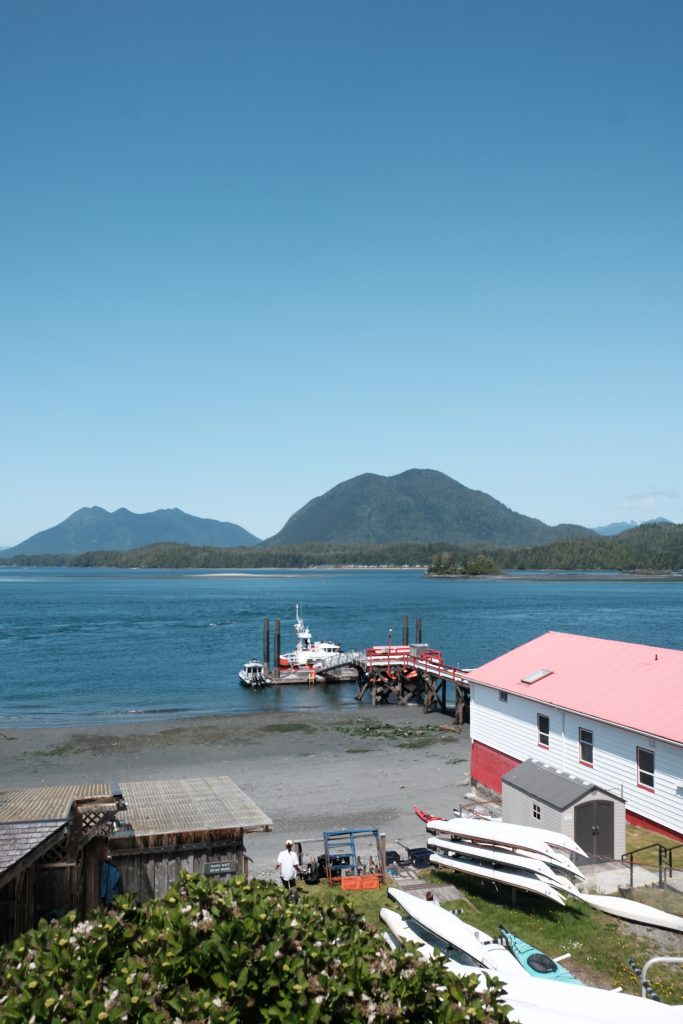

Pacific Rim National Park Reserve
How to get here: 2.5 hours from Nanaimo via Route 4 (to the visitor centre).
What to do here: Hiking, surfing, wildlife watching, kayaking
There’s something magical about the Pacific Rim National Park Reserve. It truly feels like the edge of the world, and in many ways it is. Spanning 511km2 of Vancouver Island’s wild west coast, the park is somewhat cut off from the rest of the island, with many areas connected only by boat, long, rough roads or multiple days of hiking. Adding to its allure are sandy beaches that are often shrouded in fog, unspoiled temperate rainforest, and diverse wildlife including bears, cougars and wolves.
The park is divided into three sections:
- Long Beach Unit: The most accessible and visited section of the park which lies between Tofino and Ucluelet. This is a popular area for beach walks and forest trails.
- West Coast Trail Unit: A remote section stretching from Port Renfrew to Bamfield, home to the legendary West Coast Trail, as well as the Cape Beale Headlands.
- Broken Group Islands: This section offers a network of small islands in Barkley Sound with many sheltered bays making it perfect for kayaking adventures. The islands are only accessible by boat.
Top sites in the Long Beach Unit:
- Rainforest Trail: Two short 1km loops composed of wooden boardwalks and gravel pathways which weave through well-preserved rainforest.
- Long Beach, Combers Beach and Wickaninnish Beach: Technically these three beaches are connected into one continuous stretch of sand which is ideal for walking, cycling, sunbathing or storm watching.

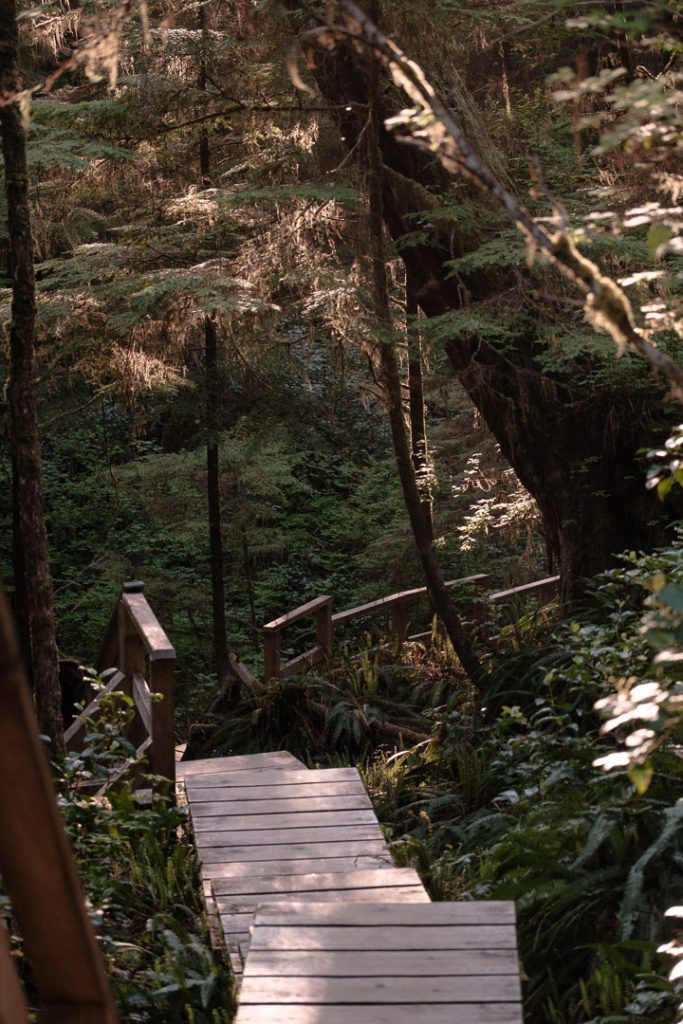
Ucluelet
How to get here: 2.5–3 hours from Nanaimo via Route 4.
What to do: Hiking, beachcombing, storm watching, wildlife tours, kayaking
Often overshadowed by its better-known neighbour Tofino, the town of Ucluelet (pronounced you-klew-let) is a more low-key and rugged alternative that’s just as scenic and even more laid-back. Ucluelet offers a deep connection to the wild west coast with crashing waves, dense rainforest, and a welcoming local community.
The vibe here is a little quieter and less commercial, but no less stunning. Ucluelet is home to the famous Wild Pacific Trail, a coastal hiking route offering some of the best ocean views on the island. Visitors can get a taste of the trail by hiking one of the sections such as the Lighthouse Loop, which passes through mossy forest with dramatic views of the coast.
Ucluelet is also a great launch point for whale watching tours, sea kayaking, and fishing charters, and you’ll often spot eagles, seals, and sea lions just from the shoreline. Nearby beaches like Big Beach and Little Beach are perfect for exploring tide pools, watching the surf, or enjoying a peaceful walk.
The town itself has a cosy and creative feel, with cafés, galleries, and restaurants that highlight local seafood and West Coast culture. In the summer there are markets showcasing local artists’ crafts. It’s also a popular destination for storm watching in winter, when massive Pacific waves pound the shore in dramatic fashion.

Other places to visit – Central Vancouver Island
While the places listed above in this guide deserve a spot on your Central Vancouver Island itinerary, the below places are also well worth a stop if you have time to do so:
Bamfield: A small, remote coastal community on the west coast of Vancouver Island. Bamfield is split by an inlet and connected by water taxis and a boardwalk. It’s a gateway to the Broken Group Islands in Pacific Rim National Park, making it popular with kayakers, boaters, and divers. Known for its rich marine life, quiet beaches, and relaxed pace, it also marks one end of the famed West Coast Trail, attracting adventurous hikers from around the world.
Goats on Roof at the Old Country Market in Coombs: A stop that’s a little different, but one we love. This is one of Vancouver Island’s quirkiest roadside stops. Located just outside Parksville, this charming market is famous for the goats that graze on its grassy roof. The market is packed with local goods, international foods, fresh baked treats, and handmade gifts at reasonable prices. The surrounding area also features boutique shops, a produce market, and cafés, making it a fun and unique place to stretch your legs, grab a bite, and pick up some one-of-a-kind souvenirs.
Cathedral Grove: Cathedral Grove, located in MacMillan Provincial Park along Highway 4 between Parksville and Port Alberni is an old-growth forest that is home to some of the island’s tallest and oldest Douglas firs trees. Some trees are over 800 years old and more than 75 metres tall. Easy, well-maintained trails weave through the towering canopy, offering a peaceful experience beneath the ancient giants. It’s a good stop for anyone heading to Tofino or Ucluelet.
Must see places: Northern Vancouver Island
Telegraph Cove
How to get here: 2 hours from Campbell River via Route 19.
What to do here: Whale watching, kayaking, hiking
Sheltered on the remote eastern coast of northern Vancouver Island, Telegraph Cove is a tiny, quaint fishing village that has become one of the island’s top eco-tourism destinations. Surrounded by forest and calm ocean waters, this colourful little cove is a launch point for some of the best whale watching in British Columbia. The nearby Johnstone Strait and Blackfish Sound are rich in marine life and are especially known for resident orca pods, as well as humpbacks, minkes, sea lions, sea otters, and more. Wildlife boat tours depart regularly, but if you’re feeling more adventurous, single or multi-day kayaking trips offer a closer, quieter way to explore these incredible waters.
The village itself is small but charming, centred around a wooden boardwalk that wraps around the cove, passing colourful historic cottages and a marina. Sadly, in 2024, a fire destroyed about a third of the boardwalk, including the Old Saltery Pub, the Killer Whale Café, and the Whale Interpretive Centre. However, the General Store and a couple of galleries remain open, and the community is already rebuilding. Even now, Telegraph Cove still holds its quiet magic. Bald eagles are often seen circling overhead, seals bob in the harbour, and whales can even be seen playing just outside of the cove.
If you have a bit of extra time and are up for a moderate challenge, the Blinkhorn Point via Dave Tarrant Trail is a rewarding hike. The trail winds through dense coastal forest and climbs to a viewpoint that overlooks the Johnstone Strait and nearby islands. The first section is steep and includes ladders and ropes, but it eases off after that. You can find the full trail details and latest conditions on AllTrails.

Strathcona Provincial Park
How to get here: 2-2.5 hours from Nanaimo via Highway 19 and Highway 28 from Campbell River.
What to do here: Hiking, kayaking, camping
Strathcona is British Columbia’s oldest provincial park, a sprawling wilderness in the heart of Vancouver Island. Covering 250,000 hectares, the park is defined by rugged mountains, glacier-fed lakes and thick temperate rainforest. Its scale and remoteness give it a sene of true backcountry adventure, making it a favourite destination for this who want to experience the island’s wild interior and alpine landscape.
For hikers, Strathcona offers an incredible variety of trails. Gentle lakeside paths provide easy walks through mossy forest, while more demanding routes climb into the alpine. Multi-day backcountry treks like the trail to Landslide Lake, framed by the towering cliffs of Mount Colonel Foster, or the trail to Della Falls one of Canada’s highest waterfalls, are bucket list challenges fro experienced hikers.
Buttle Lake, the park’s largest body of water, is a hub for. summer recreation. Here visitors can camp along the shoreline and take a kayak or canoe for a day of paddling or trout fishing.
Despite its grandeur, Strathcona remains relatively uncrowded compared to coastal destinations, which is part of its magic. On any given trip you might cross paths with black bears, Roosevelt elk or bald eagles. Strathcona is a place to disconnect and feel immersed in nature.
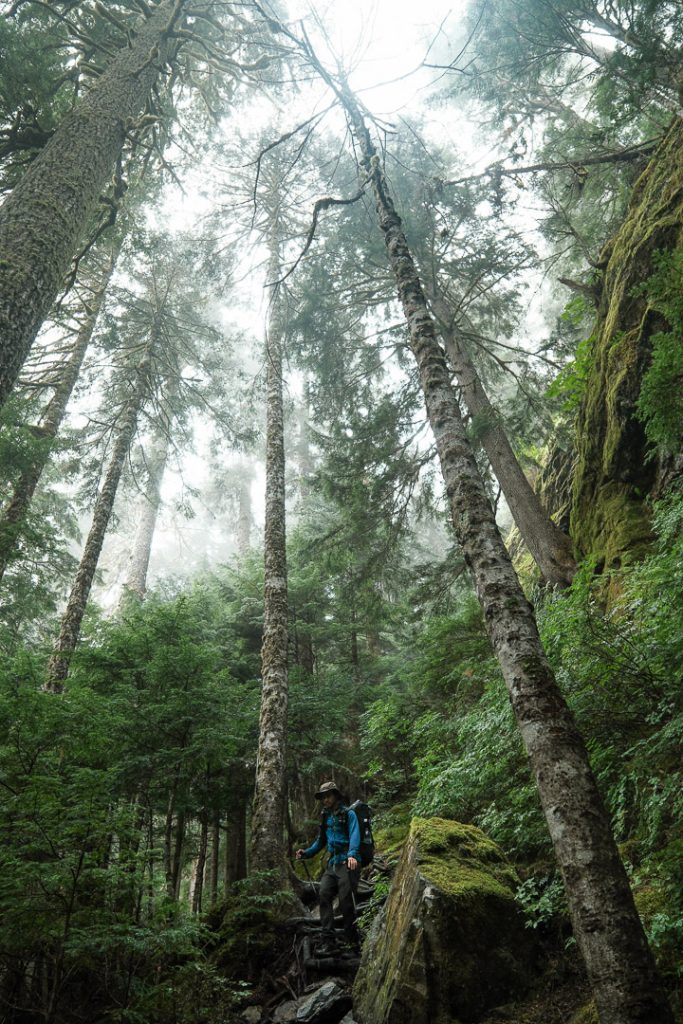
Commox
How to get here: 1.5–2 hours from Nanaimo via Highway 19.
What to do here: Oceanfront walks, kayaking, beaches, markets, hiking, snow sports (nearby Mount Washington)
Comox is a quiet coastal town with beautiful ocean views, easy access to nature, and a laid-back island feel. The town sits right on the waterfront, with views across the bay to the Coast Mountains, and offers a mix of outdoor adventure, good food, and a welcoming local vibe.
One of the best ways to experience Comox is simply to walk along the waterfront. Marina Park is a great place to start. Watch boats come and go, enjoy a picnic, or rent a kayak or paddleboard to explore the calm waters of Comox Harbour. There are a few quiet beaches in the area as well, including Goose Spit Park, a long, driftwood-strewn spit that’s perfect for sunset walks, swimming, or a beach fire in the designated rings. The town has a strong connection to the sea, and that comes through in its local food scene. You’ll find fresh seafood, craft breweries, farmers markets, and cozy cafés. In summer, the Comox Valley Farmers’ Market is a must-visit, offering everything from local produce to artisan goods and live music.
In winter, Comox makes a great base for snow sports at nearby Mount Washington Alpine Resort, just 40 minutes away, which offers skiing, snowboarding, snowshoeing and stunning views across the island.

Other places to visit – Northern Vancouver Island
While the places listed above in this guide deserve a spot on your Northern Vancouver Island itinerary, the below places are also well worth a stop if you have time to do so:
San Josef Bay: Located in Cape Scott Provincial Park, San Josef Bay is famous for its wide sandy beaches, sea stacks, and remote, untouched beauty. A relatively easy 2.5 km trail through coastal forest leads to the shoreline, where you can explore tide pools, sea caves and dramatic rock formations. It’s an accessible spot in the park and a favourite for photographers, beachcombers, and campers seeking solitude at the edge of the island.
Campbell River: Campbell River is a prime destination for wildlife tours into the Great Bear Rainforest. While the town itself is low-key, it’s a great base for exploration further afield and joining a once-in-a-lifetime wildlife tour.
Cumberland: Cumberland is a small, artsy village nestled in the Comox Valley, with a rich coal mining history and a strong community vibe. It’s best known today for its mountain biking trails, which draw riders from all over the island. Additionally, the main street is lined with indie cafés, craft breweries, vintage shops, and live music venues, giving it a creative feel.
Let is know if you have any questions in the comments box below. We’d love to hear your thoughts on these places or if there’s anywhere else you’d recommend to visitors.
